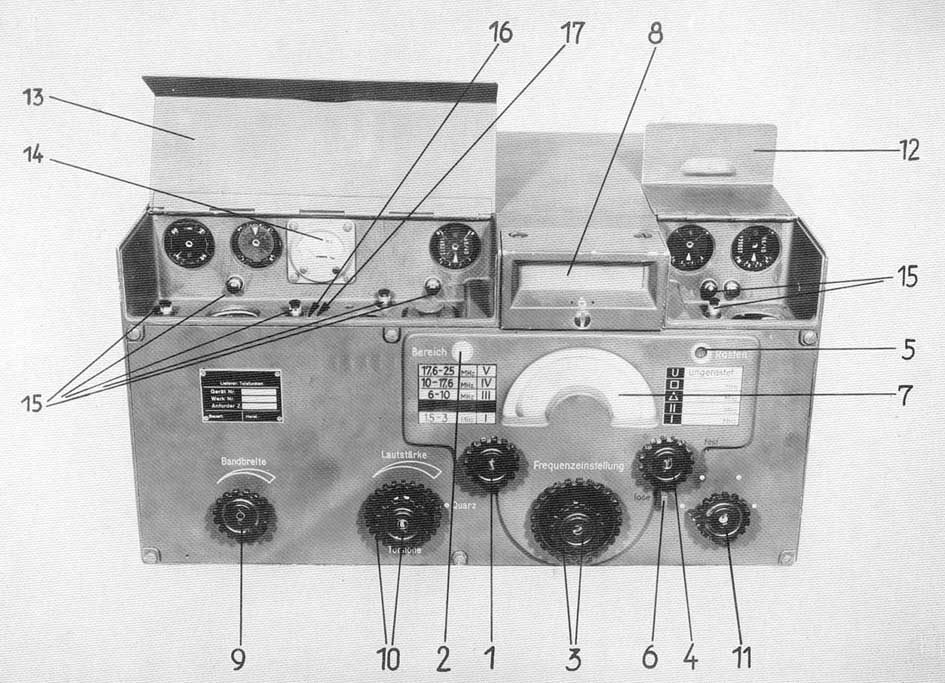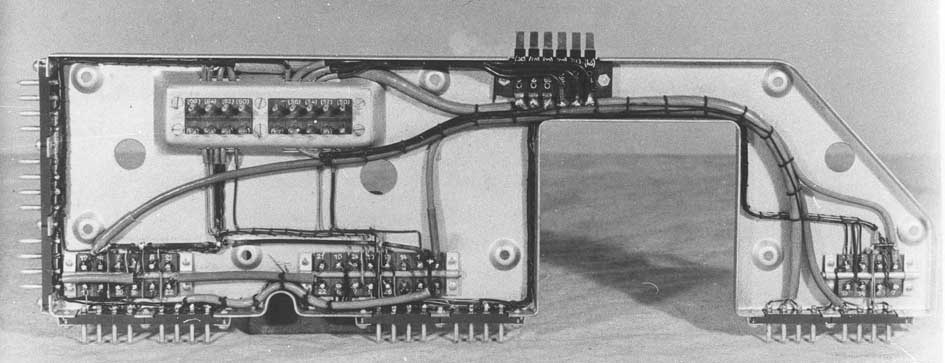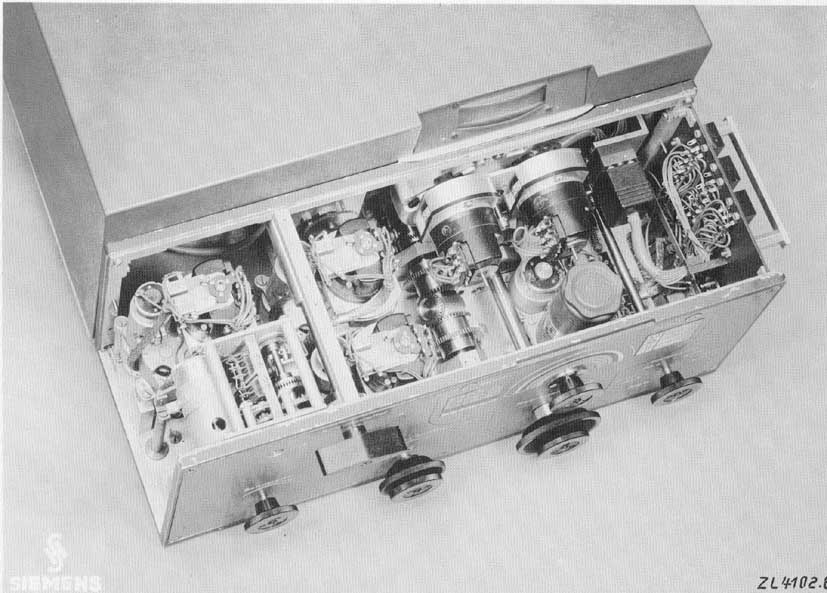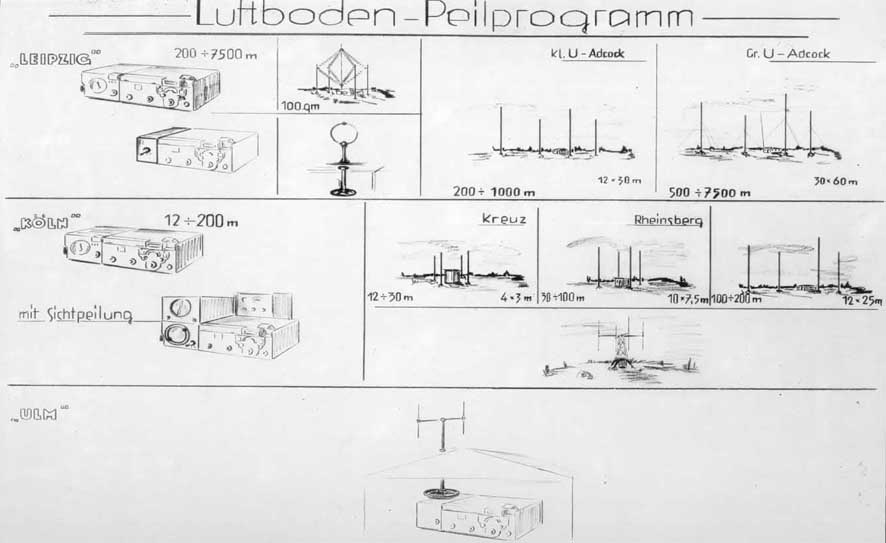
Photograph selection, derived from the 1941 Telefunken catalogue called: "Luftboden- Empfänger-Programm", presumably, the only remaining copy in the world.
Please consider for full text support the PDF (3.7 MB) version of this report.
To increase the printing quality, please select an illustration by means of Ctr+C and paste it into Word or WordPerfect, by means of Ctr+V. You will discover, that the photo quality is good.

Köln E52a prototype V1 (Versuchsmuster 1), state of affairs Spring 1941
1. Range selector switch; 2. Frequency range (Bereich I-V) indication window; 3. Source and fine frequency tuning (all knobs differ from the serial apparatus); 4. 1 out of 4 memory pre-settings (band and frequency setting, for quick receiver tuning); 5. Pre-setting indication window; 6. Selector switch for memory pre-setting; 7. Source frequency scale, in case of scale projection failure; 8. Microfilm frequency projection screen; 9. Quartz-filter bandwidth-tuning 200 - 5000 Hz (state of 1941!); 10. BFO and audio-level tuning; 11. Mode settings for A1, A2/3, with or without AGC (AVC); 14. Control meter for checking valve function and sensitivity of the Köln receiver, only available in type E52a; 15. Valve function test buttons; 16/17 E52a sensitivity testing.

Köln E52a prototype V1
1. Motor-shaft access, meant to be linked onto the remote control unit (see photos down on this page); 2. Frequency projection (stored at a microfilm glass disc); 3. Glass disc fixing; 4. shaft of the source tuning pointer; 5. Range selector switch; 6/7. Memory pre-selector setting; 8. Bandwidth tuning; 9. BFO tuning or switch to select quartz controlled BFO; 10. Audio level control; 11. Audio stage components (consider also Krachtöter); 12/13. Frequency source and fine tuning.

Mother-board of Köln E52a receiver. The wiring is normally not visible, because it is screened off by both its metal carrier and the die-cast frame of the Köln receiver.
Remote control to Köln E52a and Ulm E53
There are indications, that the remote control to the "Luftboden-Empfänger-Programm" never saw active serve. We may consider, that only a few samples had been manufactured (Null-Serie). The remote control devices were developed by Siemens & Halske. We may regard, that development started in 1939/1940. The photos shown in the May 1941 catalogue make it clear that, at that time, the system was only in a preliminary state of development. And, certainly, was not (yet) ready for system trials.
The project, nevertheless, showed rather advanced technologies. Such as, for example, binary coded remote control frequency-shift signal-transfer (FSK 60 Hz). Either by means of serial or parallel data transfer. Read for full explanation: "Luftboden- Empf.-Programm" (PDF 3.7 MB)

Remote control project to the "Luftboden-Empfänger-Programm" (state of the art of 1939/1940)
On the left-hand side the master unit is shown (Fernsteuergeber). It was supposed that it should control the Köln slave unit (the centre apparatus) by means of telephone signals. The slave unit (Fernsteuervorsatz) is mounted to the front section of a Köln receiver (of course, the front panel had to be removed firstly). On the right we see the (projected) interface units. Of which, presumably, one unit reached actual trials.

Binary coded data transfer of Köln remote control signals (Siemens & Halske)(1939-1940) We can clearly notice, that this is a rather elaborate device. The movement of the various tuning servos were being controlled by means of electronic phase-error correction technology. (see text of the Luftboden-Empfänger-Programm)

Fernbedienung über Trägerfrequenz (binary coded data transfer, by means of carrier telephony)
Luftboden-Peilprogramm (air-ground Direction Finding project, HF/DF)

Keywords: Leipzig E51; Köln mit Sichtpeiler E52; Ulm E53; various directional antennas. It is evident, that this Luftboden-Empfänger-Programm catalogue of 1941, was meant to show the German Air force (GAF)(Luftwaffe) what systems could be purchased. Most of these systems never reached a mature state. Only Köln and Ulm had been purchased by their military services. Some researchers have searched most of their life to disclose details on the DF unit to the Köln (Peil-Vorsatz), others worked to discover details on the remote control unit to it. Neither of them was yet successful.
Schematic diagram (Schaltbild) of E52a (PDF)
Schematic diagram of Köln E52a (PDF), is based on the 1943 manual. The mother-board is called BUS in this illustration. Its central structure is easy to understand.
To close the contribution on this page, I would like to show the quartz-bandfilter-curves of one of my Köln IF modules (ZF-Baustein), which were measured in the early 1990s by Donald Prins. He was, in those days, a physicist at the Philips Quartz Factory in Doetichem, in the Netherlands.
Back to: Köln E52 main page
Consider also: Eichmaschine patent